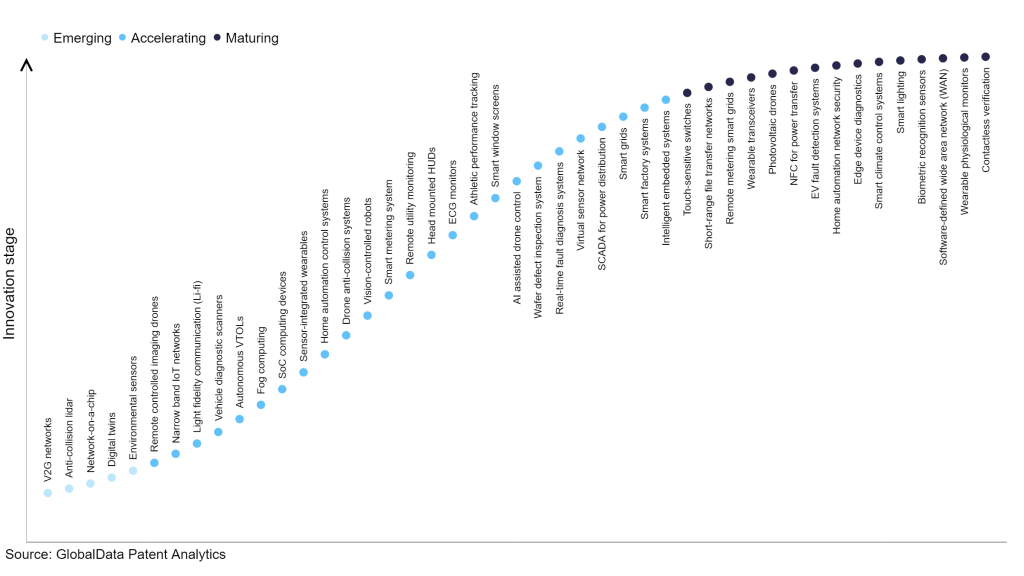The technology industry continues to be a hotbed of innovation, with activity driven by the amalgamation of technological progress, heightened connectivity, and the urgency for businesses to enhance efficiency and competitiveness in an ever-changing marketplace, and growing importance of technologies such as radio-frequency identification, near field communication, biometric recognition, and quick response codes. These technologies play a crucial role in enabling secure and convenient contactless verification in various applications, such as access control, ticketing systems, mobile payments, and identity verification. In the last three years alone, there have been over 3.6 million patents filed and granted in the technology industry, according to GlobalData’s report on Innovation in Internet of Things: Contactless verification. Buy the report here.
However, not all innovations are equal and nor do they follow a constant upward trend. Instead, their evolution takes the form of an S-shaped curve that reflects their typical lifecycle from early emergence to accelerating adoption, before finally stabilising and reaching maturity.
Identifying where a particular innovation is on this journey, especially those that are in the emerging and accelerating stages, is essential for understanding their current level of adoption and the likely future trajectory and impact they will have.
300+ innovations will shape the technology industry
According to GlobalData’s Technology Foresights, which plots the S-curve for the technology industry using innovation intensity models built on over 2.5 million patents, there are 300+ innovation areas that will shape the future of the industry.
Within the emerging innovation stage, environmental sensors, digital twins, and network-on-a-chip are disruptive technologies that are in the early stages of application and should be tracked closely. Intelligent embedded systems, smart factory systems and smart grids are some of the accelerating innovation areas, where adoption has been steadily increasing. Among maturing innovation areas, contactless verification, wearable physiological monitors, and software-defined wide area network, are now well established in the industry.
Innovation S-curve for IoT in the technology industry

Contactless verification is a key innovation area in IoT
Contactless verification refers to the authentication process that utilises contactless technology to confirm the identity of individuals or objects, such as facial recognition, fingerprints, or other biometric data. This method enables fast and secure authentication without the need for physical contact between the user and the device. Contactless verification finds application in various scenarios, including mobile payments, ticketing systems, and access control, among others.
GlobalData’s analysis also uncovers the companies at the forefront of each innovation area and assesses the potential reach and impact of their patenting activity across different applications and geographies. According to GlobalData, there are 750 companies, spanning technology vendors, established technology companies, and up-and-coming start-ups engaged in the development and application of contactless verification.
Key players in contactless verification – a disruptive innovation in the technology industry
‘Application diversity’ measures the number of different applications identified for each relevant patent and broadly splits companies into either ‘niche’ or ‘diversified’ innovators.
‘Geographic reach’ refers to the number of different countries each relevant patent is registered in and reflects the breadth of geographic application intended, ranging from ‘global’ to ‘local’.
Patent volumes related to contactless verification
Source: GlobalData Patent Analytics
SoftBank Group is one of the leading patent filers in contactless verification. The company’s patents are aimed at a two-dimensional code generation request received by a server from a two-dimensional code display client. The server generates static, two-dimensional code information and a random feature and send them to the two-dimensional code display client.
A two-dimensional code verification request is sent by a two-dimensional code scanning client to the server. A two-dimensional code scanning status value is sent by the server to the two-dimensional code scanning client.
Other prominent patent filers in the space include Toshiba and Avery Dennison.
In terms of geographic reach, Intuitive Surgical leads the pack, followed by Paycasso Verify and Artemis Group. In terms of application diversity, CellAegis Devices holds the top position, followed by Fisher & Paykel Healthcare and Seven & i.
Contactless verification has ability to provide a hygienic, convenient, secure, and efficient authentication process across various applications and industries. It enhances user experience, improves security, and contributes to a safer and more streamlined interaction between individuals and systems.
To further understand how IoT is disrupting the technology industry, access GlobalData’s latest thematic research report on Internet of Things – Thematic Research.
Data Insights
From

The gold standard of business intelligence.
Blending expert knowledge with cutting-edge technology, GlobalData’s unrivalled proprietary data will enable you to decode what’s happening in your market. You can make better informed decisions and gain a future-proof advantage over your competitors.







